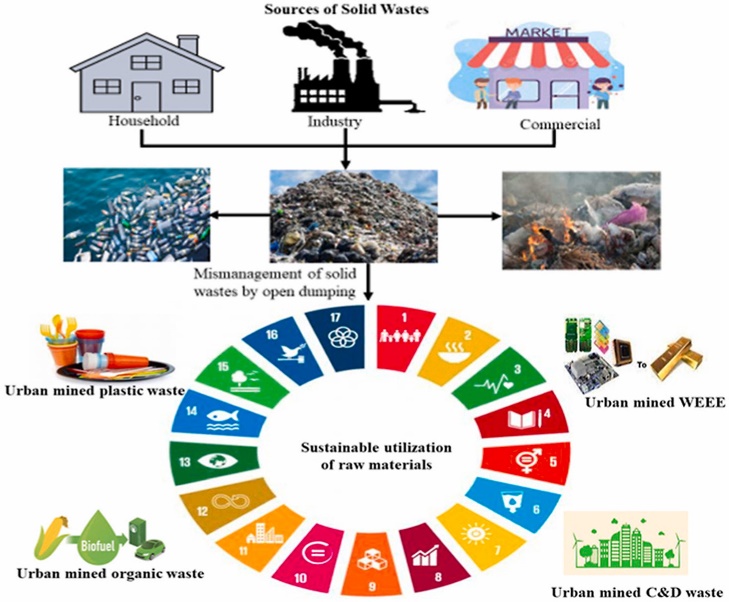- Courses
- ABOUT US
- OUR TOPPERS
- TEST SERIES
- FREE STUDY MATERIAL
- VIDEOS
- CONTACT US
Solid Waste Management
Solid Waste Management
01-05-2023


Latest Context
Recently, the incident of the attack of a stray dog in Srinagar highlighted the linkage between street dog attacks and Poor Solid Waste Management.
Poor Waste Management and its Connection to Increasing Attacks by Street Dogs
- Wastage of Food: On average, Indian homes generated 50 kg of food waste per person in 2019. It acts as a source of food for hunger-stricken, free-roaming dogs. In search of food, they move towards densely populated areas in cities.
- Tepid Animal Birth Control and Insufficient Rescue Centers: This waste food often becomes a source of food for hunger-stricken free-ranging dogs in urban areas, who always search for food around exposed garbage dumping sites, like landfills or garbage dumps. While there is no evidence that shows the municipal waste and its mismanagement directly led to an increase in dog bites. In Indian context, tepid animal birth control program coupled with insufficient rescue centers in conjunction with poor waste management results in a proliferation of street animals in India and the consequent attacks.
Issues with India’s Solid Waste Management
- Unsegregated Waste: In India, solid wastes comprise solid or semi-solid domestic waste, sanitary waste, commercial waste, institutional waste, catering, and market waste. In addition, it also includes other non-residential wastes, street sweepings, silt removed or collected from the surface drains, horticulture waste, agriculture, and dairy waste, treated biomedical waste excluding industrial waste, bio-medical waste, and e-waste, battery waste, radioactive waste, etc.
- Large Proportion in Global Municipal Waste: India constitutes roughly 18% of the world's population and 12% of global municipal waste generation. Each year, India generates 62 million tonnes of waste. Approximately, 43 million tonnes (70%) are collected, of which about 12 million tonnes are treated, and 31 million tonnes are dumped in landfill sites. Changing consumption patterns and rapid economic growth can also lead to an increase in municipal solid waste generation up to 165 million tonnes by 2030.
Reasons for Poor Solid Waste Management in India
- Poor Implementation: A 2020 research paper pointed out that most metro cities are littered with garbage bins that are either old, damaged, or insufficient in containing solid wastes. Urban local bodies are unable to implement and sustain rules under the Solid Waste Management Rules 2016 like door-to-door collection of segregated waste, studies show. Furthermore, the implementation of these rules has become more cumbersome due to very poor public awareness.
- Proximity with Slums: Most of the landfills and dumping sites are located on the peripheries of cities adjacent to slums and settlement colonies. In Mumbai, some of the cheapest houses can be found near Deonar, which is located on the verge of 256 slums and 13 resettlement colonies. Therefore, Therefore, people residing in urban areas also cause an increase in dog biting. As per reports, 300 people living in Pune’s Shivneri Nagar slum complained of stray dog bites in the area in 2021.
- Absence of Data Collection Mechanism: India does not have time series data or panel data in connection with solid or liquid waste that makes it very difficult for private entities to understand the relationship between the cost and benefits of waste management policies for entering the market.
Initiatives Related to Waste Management
- Solid Waste Management Rules 2016: These rules replaced the Municipal Solid Wastes (Managemen
 t and Handling) Rules, 2000. They will focus on the segregation of waste at source, the responsibility of the manufacturer to dispose of sanitary and packaging wastes, user fees for collection and disposal, and processing from the bulk generator.
t and Handling) Rules, 2000. They will focus on the segregation of waste at source, the responsibility of the manufacturer to dispose of sanitary and packaging wastes, user fees for collection and disposal, and processing from the bulk generator. - Waste to Wealth Portal: Its objective is to identify, develop, and deploy technologies to treat waste to generate energy, recycle materials, and extract resources of value.
- Waste to Energy: A waste-to-energy or energy-from-waste plant converts industrial and municipal solid waste into electricity and/or heat for industrial processing.
- Plastic Waste Management (PWM) Rules, 2016: It makes special provisions for the generators of plastic waste to take steps for minimizing the generation of plastic waste, prevent littering of plastic waste along with ensuring segregated storage of waste at source among other measures. In Feb 2022, Plastic Waste Management (Amendment) Rules, 2022 were notified.
- Project REPLAN: Its motto is to make carry bags by mixing processed and treated plastic waste with cotton fiber rags in a ratio of 20:80.
- Plastic Waste Management (Amendment) Rules, 2022: These rules clearly define the responsibilities of various stakeholders like manufacturers, importers, retailers, and consumers. All these stakeholders have a role to play in ensuring that plastic waste is managed properly and does not end up polluting the environment.
Way Forward
- To improve waste management in public spaces and control feeding around bakeries that can reduce the carrying capacity of the environment.
- Improving the waste disposal facilities is crucial for reducing such incidents. Just rely on dog sterilization and vaccines won't be enough.
- Moreover, decentralized waste management systems can be introduced at the community level for reducing the burden of handling large volumes of municipal waste at a centralized location, provide job opportunities for informal workers, and reduce transportation and storage costs.
- Technology-driven recycling can be encouraged by taking the recourse of research and development at the university and school level to promote active participation in waste management.


